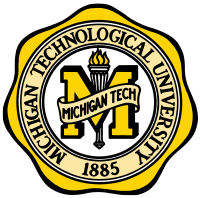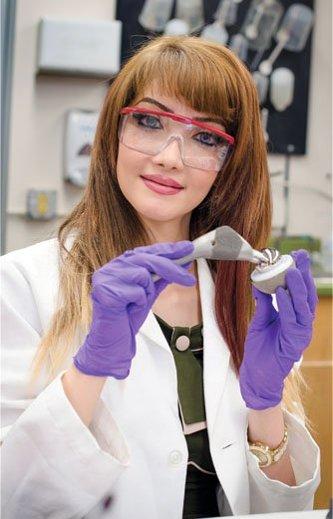 3D bioprinting is already being used in a number of bioprinting applications that are quite stunning to the general public just becoming educated on the subject; and no matter your level in science, biology, technology, and more—what 3D printing can offer will make anyone shake their head in wonder.
3D bioprinting is already being used in a number of bioprinting applications that are quite stunning to the general public just becoming educated on the subject; and no matter your level in science, biology, technology, and more—what 3D printing can offer will make anyone shake their head in wonder.
From everything to 3D printed skin and 3D printed thyroids, to the hopes of soon being able to use 3D printing for organ transplants, the integration of live cells is a big conversation within this new age of technology and for a select few researchers—it’s a big, and very real, project.
Currently, researchers at Michigan Technological University are among the select few who are actually working in bioprinting, not only becoming seriously proficient at 3D printing but also in searching for bio-inks that are suitable for what they need to use as material for actually making 3D printed tissue—a process that is in the works long before you begin reading about it in the headlines.
Dr. Tolou Shokuhfar is an assistant professor of mechanical engineering and biomedical engineering at Michigan Tech. Directing the In-Situ Nanomedicine and Nanoelectronics Laboratory at Michigan Tech, she also serves as adjunct assistant professor in the bioengineering department and the College of Dentistry at the University of Illinois at Chicago. Currently Dr. Shokuhfar and Dr. Reza Shahbazian-Yassar are working together in attempting to 3D print live tissue, making good use of Dr. Shahbazian-Yassar’s experience in cellulose nanocrystals.
A Richard and Elizabeth Henes Associate Professor in the Department of Mechanical Engineering-Engineering Mechanics at Michigan Tech, Dr. Shahbazian-Yassar shares the fact that nerves are based on electric impulse. Due to Dr. Shokuhfar’s work with that concept, using graphene, she was given a CAREER grant from National Science Foundation (NSF) for her work.
“Graphene is a wonder material,” she said. “And it has very good electrical conductivity properties.”
This is just one of the materials they are studying for use in regenerative 3D printing, hoping to reach ambitions of perhaps being to further help patients with spinal cord injuries one day. The bioprinting lab is currently being funded by the NSF Biomaterials program, as they delve into an extremely challenging and difficult area of research.
“We wanted to target a big issue,” Dr. Shokuhfar says. “We are born with all the nerve cells we’ll ever have, and damaged nerves don’t heal very well.”
 The team points out that projects on this scale and with such level of complexity are often more successful when sticking with simplicity.
The team points out that projects on this scale and with such level of complexity are often more successful when sticking with simplicity.
“We can pursue nerve regeneration research with a simpler printer set-up,” says Shayan Shafiee, a PhD student researching and working with Dr. Shokuhfar and her team. “Our work always comes back to the question, is it printable or not?”
Their current 3D printing system uses a syringe and needle system for making what are so far small bits of tissue which must be built slowly, layer by layer, from a red, thick, syrupy polymer material.
There are no standards yet, so it is up to researchers to truly explore the great unknown and by trial and error figure out which equipment, software and materials–as well as all the processes involved in between–will work. While they don’t have a roadmap to work from, they do have the exciting adventure in being bioprinting pioneers, making the rules as they go along.
What do you think the implications of making 3D printed tissue are, with hopes to be able to help patients who currently have severe nerve damage? Tell us your thoughts in the Researchers Pioneering 3D Printing of Tissue forum thread over at 3DPB.com.
Subscribe to Our Email Newsletter
Stay up-to-date on all the latest news from the 3D printing industry and receive information and offers from third party vendors.
You May Also Like
Precision at the Microscale: UK Researchers Advance Medical Devices with BMF’s 3D Printing Tech
University of Nottingham researchers are using Boston Micro Fabrication‘s (BMF) 3D printing technology to develop medical devices that improve compatibility with human tissue. Funded by a UK grant, this project...
GaeaStar and Verve Coffee Roasters Start Pilot Production of Sustainable 3D Printed Coffee Cups
Following a 2022 debut in Germany, GaeaStar, a startup based in San Francisco and Berlin, has begun US pilot production of its sustainable, disposable clay cups and bowls made with...
Meltio and Accufacture Unveil Robotic Metal 3D Printer Made in the US
Meltio has partnered with Michigan-based robotics firm Accufacture to introduce Alchemist 1, a robotic cell designed for wire-laser metal 3D printing made in the US. This new system represents a...
WASP Highlights Advances in Healthcare 3D Printing at Italy’s Exposanità 2024
WASP takes center stage at Italy’s leading healthcare expo, Exposanità 2024, demonstrating the transformative impact of its advanced 3D printing technologies on the medical sector. Known for its line of...


































